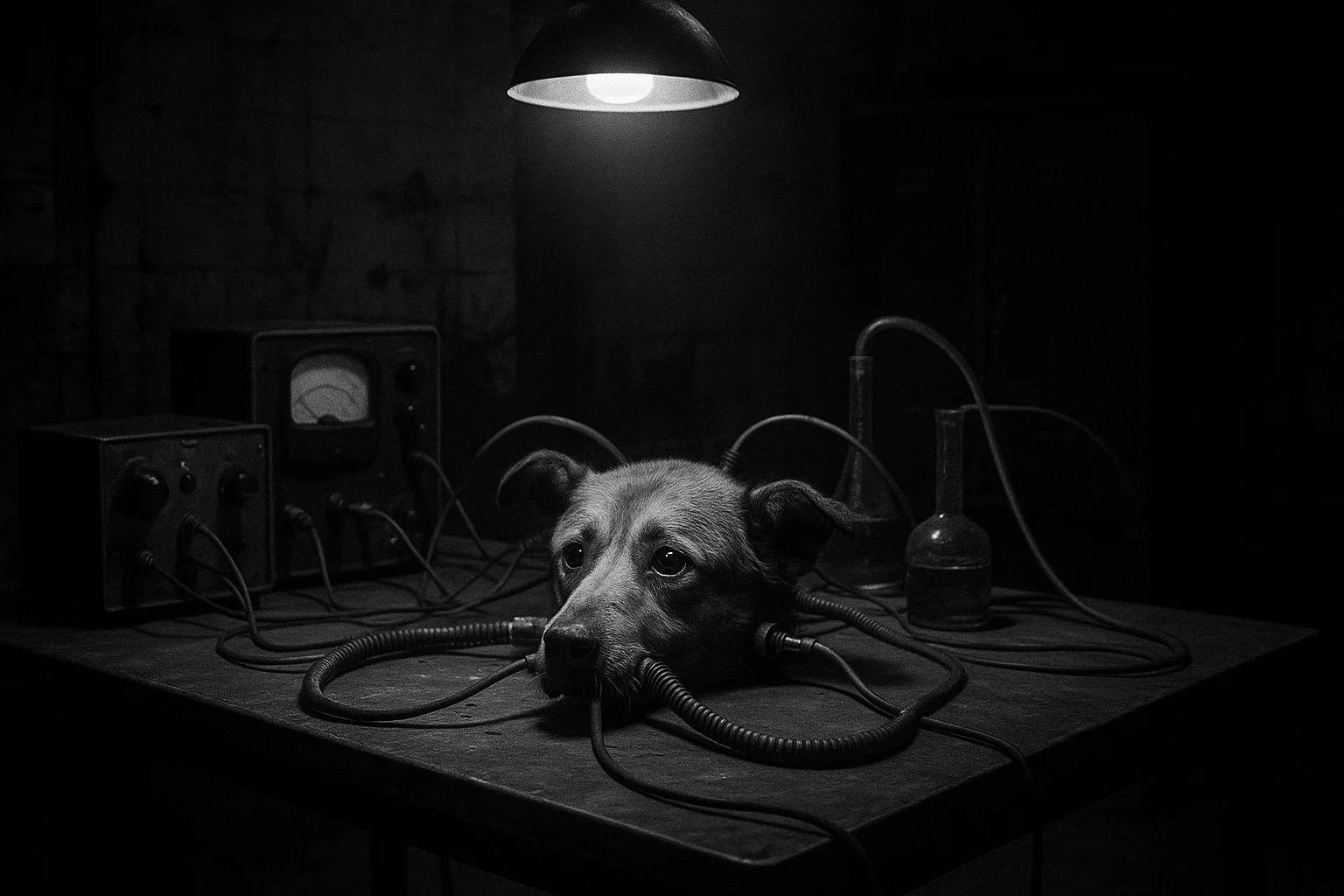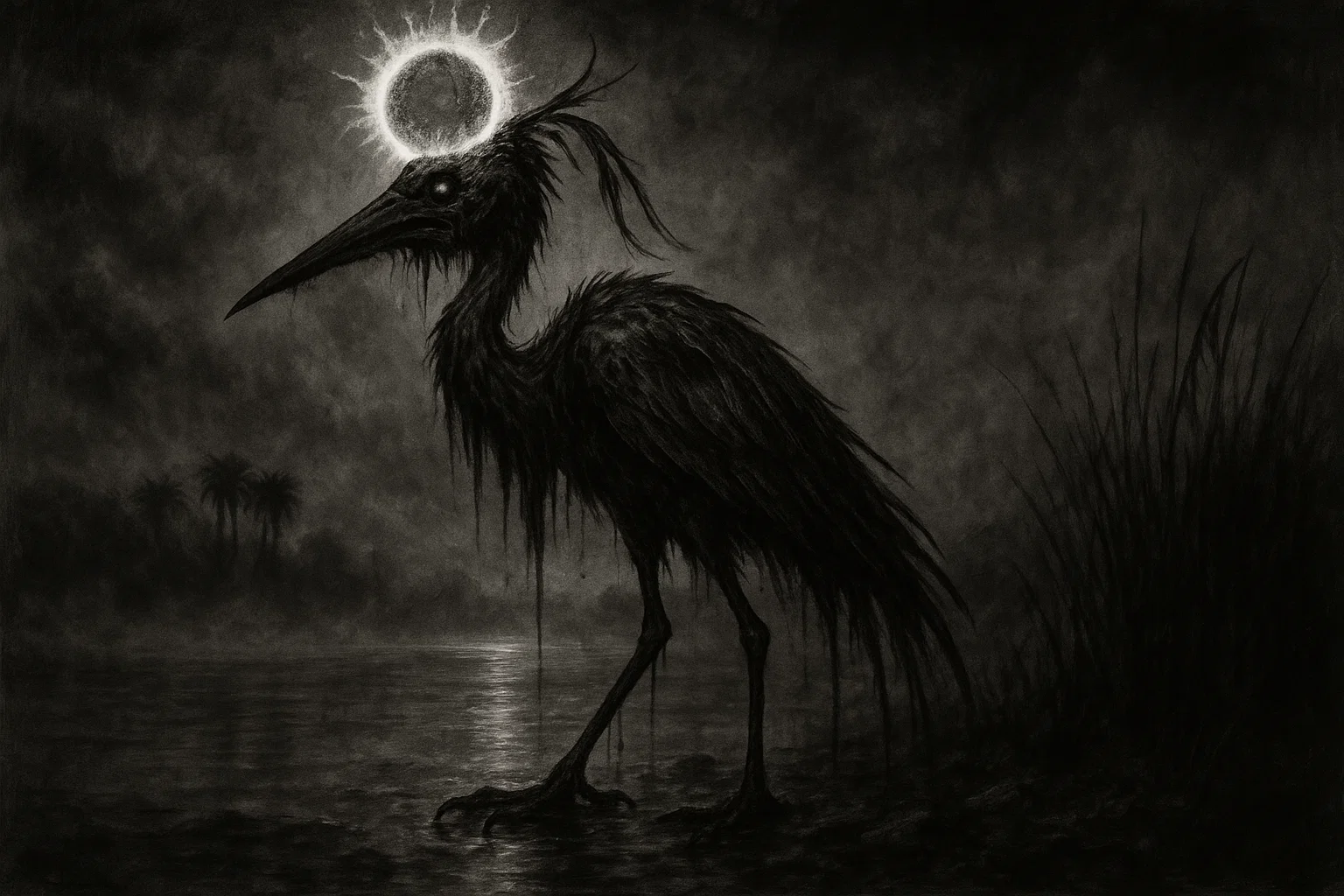The dog head experiment, conducted by Soviet physiologist Sergei Brukhonenko in the 1920s and 1930s, stands as one of the most audacious and controversial ventures in medical science.
Using a device called the autojector, Brukhonenko claimed to sustain a severed dog’s head, keeping it responsive to stimuli like light, sound, and touch.
These experiments, showcased in the 1940 documentary Experiments in the Revival of Organisms, aimed to push the boundaries of life and death, contributing to early heart-lung machine technology.
However, their graphic nature and questionable authenticity sparked global fascination and ethical outrage.
Summary
Overview
| Aspect | Details |
|---|---|
| Lead Scientist | Sergei Brukhonenko, Soviet physiologist (1890–1960) |
| Time Period | 1925–1939 |
| Key Device | Autojector, a primitive heart-lung machine for artificial circulation |
| Main Experiment | Sustained a severed dog’s head, showing reflexes (e.g., blinking, swallowing) |
| First Demonstration | 18 September 1925, Second Congress of Russian Pathologists, Moscow |
| Key Claim | Revived 12/13 dogs after 10 minutes of clinical death (1939) |
| Documentary | Experiments in the Revival of Organisms (1940), directed by David Yashin |
| Controversies | Ethical concerns over animal cruelty; doubts about authenticity |
Who Was Sergei Brukhonenko?
Sergei Sergeevich Brukhonenko (1890–1960) was a towering figure in Soviet physiology, driven by an insatiable curiosity about the mechanics of life.
Born in Kozlov (now Michurinsk, Russia), he graduated from Moscow University in 1914 with a medical degree. His early career coincided with World War I, where he served as a military surgeon, gaining firsthand experience with traumatic injuries and blood loss. This shaped his lifelong interest in resuscitation and artificial circulation.
After the war, Brukhonenko joined the Institute of Experimental Physiology and Therapy in Moscow, where he rose to prominence under the mentorship of Ivan Pavlov, the Nobel laureate known for his work on conditioned reflexes.
By the 1920s, Brukhonenko was leading groundbreaking research, focusing on sustaining organs outside the body. His invention of the autojector—a device that oxygenated and circulated blood—marked a pivotal moment in medical technology.
His work earned him the prestigious Lenin Prize posthumously in 1961, recognizing his contributions to cardiac surgery and organ preservation.
Brukhonenko’s career was not without challenges. Operating in the Soviet Union under Stalin’s regime, he navigated a landscape where scientific achievement was often intertwined with political propaganda.
His experiments were funded generously—evidenced by a 30,000-ruble grant from Narkomzdrav in 1928—but also scrutinized for their potential to bolster Soviet prestige.
Despite personal risks, including scrutiny during Stalin’s purges, Brukhonenko remained dedicated, publishing extensively in journals like Journal de physiologie et de pathologie générale and presenting at international conferences.
You May Also Like: Is Mamlambo Real? Mythical Snake, Mermaid, or Real-Life Monster?
The Soviet-American Scientific Race
The dog head experiments unfolded during a period of intense scientific rivalry between the Soviet Union and the United States, which escalated into the Cold War by the 1950s and 1960s.
This competition, rooted in ideological differences between communism and capitalism, extended beyond military and space exploration to biomedical research.
Both nations sought to demonstrate technological supremacy, with science serving as a battleground for global influence.
In the Soviet Union, experiments like Brukhonenko’s were part of a broader push to showcase innovation. The 1940 documentary Experiments in the Revival of Organisms was screened in Western capitals, including London (1942) and New York (1943), to project Soviet prowess.
The U.S., meanwhile, invested heavily in medical advancements, particularly after World War II, with milestones like the first heart-lung machine used in surgery by John Gibbon in 1953.
This machine owed conceptual debts to Brukhonenko’s autojector, though American scientists rarely acknowledged Soviet contributions due to political tensions.
The scientific race fueled bizarre and ethically questionable experiments on both sides:
- Soviet Experiments: Beyond Brukhonenko, Vladimir Demikhov conducted two-headed dog transplants in the 1950s, grafting the head of one dog onto another’s body to study organ compatibility. These grotesque procedures aimed to advance transplantation but horrified observers.
- American Experiments: The U.S. explored equally unsettling avenues, such as Project MKUltra (1950s–1970s), a CIA program involving human subjects to test mind-control drugs and psychological manipulation. While not directly related to organ revival, it reflected a willingness to push ethical boundaries.
- Head Transplantation Attempts: In the 1960s, American neurosurgeon Robert J. White performed head transplants on monkeys, achieving partial success by maintaining brain activity post-transplantation. These experiments, conducted at Case Western Reserve University, drew criticism for their cruelty and limited practical value.
The rivalry stemmed from mutual distrust and the desire to assert dominance in a post-war world.
The Soviet Union’s closed system allowed for less public scrutiny of experiments, while the U.S. faced growing ethical oversight, particularly after the Nuremberg Code (1947) emphasized informed consent and humane treatment in research.
The Dog Head Experiment
Experimental Design and Execution
The dog head experiments, initiated in 1925, aimed to sustain isolated organs and revive clinically dead organisms. Brukhonenko’s team, including collaborator Sergei Chechulin, worked at the Institute of Experimental Physiology and Therapy in Moscow.
The experiments involved severing a dog’s head and connecting it to the autojector, a device that mimicked the body’s circulatory system.
The autojector comprised two main components:
- Diaphragm Pump: Drew deoxygenated blood from the head, mimicking venous return. The pump used a vacuum system to ensure steady flow without damaging blood cells.
- Oxygenation Chamber: Saturated blood with oxygen using a bubble oxygenator, a precursor to modern membrane oxygenators. The chamber also removed carbon dioxide and maintained blood temperature at 37–40°C to prevent hypothermia.
The head was connected via rubber cannulae inserted into the carotid arteries and jugular veins, with citrated blood (treated with sodium citrate to prevent clotting) circulated through the system.
Heparin, a more effective anticoagulant, was not widely available until the 1930s, so citrate was used despite its limitations, such as potential toxicity to tissues.
You May Also Like: Who Is Seere? The 70th Demon of the Ars Goetia
Key Demonstrations
On 18 September 1925, at the Second Congress of Russian Pathologists in Moscow, Brukhonenko showcased a severed dog’s head sustained for 1 hour and 40 minutes.
The head displayed:
- Corneal Reflexes: Blinking in response to light or touch.
- Auditory Responses: Ear twitches when exposed to loud sounds, such as a hammer strike.
- Oral Reactions: Licking or swallowing when substances like cheese or citric acid were placed near the mouth.
By 1928, refinements to the autojector extended survival times to 100 minutes, with some reports claiming up to 24 hours (Komsomol Truth, 22 May 1927). These claims, however, are debated due to inconsistencies in documentation.
Brukhonenko also experimented with whole-body revival. In 1939, he reported reviving 12 out of 13 dogs after inducing clinical death by exsanguination (draining blood) for 10 minutes.
The autojector restored circulation, and the dogs reportedly regained consciousness, with some surviving for months or years. However, skeptics argue that neurological damage was likely, and long-term survival may have been exaggerated.
Technological Innovations
The autojector’s design was revolutionary for its time:
- Materials: Used glass reservoirs and rubber tubing, sterilized to prevent infection. The pump’s diaphragm was made of vulcanized rubber, ensuring durability.
- Blood Management: Blood was filtered through a gauze mesh to remove clots and impurities, a crude but effective method.
- Control Systems: Manual valves regulated flow and pressure, requiring constant monitoring by technicians to prevent air embolisms or over-pressurization.
These innovations influenced later devices, such as the Gibbon heart-lung machine and the DeBakey pump, used in modern cardiac surgery.
Public Presentations
Brukhonenko presented his findings at multiple conferences:
- May 1926: Second Congress of Soviet Physiologists, Leningrad, where he demonstrated the autojector’s ability to sustain a dog’s heart.
- May 1928: Congress of Soviet Physiologists, Moscow, with five detailed reports on organ revival.
- 1937: Published in Nature, detailing the perfected autojector design.
These presentations, often accompanied by live demonstrations, captivated audiences but also fueled ethical debates.
You May Also Like: Photographs from Another World | Horror Story
Was the Dog Head Experiment Real?
The dog head experiments have long been shrouded in controversy, with questions about their authenticity persisting decades later.
The 1940 documentary Experiments in the Revival of Organisms, directed by David Yashin, is the primary visual evidence, showing a severed head responding to stimuli. However, experts have raised doubts about its credibility.
J.B.S. Haldane, a British scientist who narrated the English version of the film, initially endorsed its claims but later expressed reservations, noting in a 1945 lecture that the footage seemed “too perfect” to be unedited.
Film analysis by Sergei Petrov, a Russian historian, in 1998 suggested possible optical trickery, such as staged movements or edited sequences to exaggerate the head’s responsiveness. Petrov pointed to inconsistencies in lighting and frame continuity, though he lacked definitive proof of fabrication.
Nikolai Krementsov, a historian of Soviet science, argued in a 2009 study that the experiments were likely real but overstated for propaganda purposes.
The Soviet Union, eager to assert scientific dominance, may have embellished survival times or neurological outcomes. For example, claims of a head surviving 24 hours (Komsomol Truth, 1927) contrast with Brukhonenko’s own reports of 100 minutes, suggesting journalistic exaggeration.
Expert Analysis of the Footage
In 2010, Dr. Maria Volokhova, a Russian neurologist, analyzed the documentary footage and concluded that the head’s reflexes—such as blinking and swallowing—were plausible given the autojector’s ability to maintain cerebral blood flow.
However, she noted that prolonged survival (beyond a few hours) would be unlikely due to ischemic damage to brain tissue, as citrate-treated blood could not fully replicate the body’s natural homeostasis.
American physiologist Dr. Robert Cornish, who conducted similar experiments in the 1930s, reviewed Brukhonenko’s work and found it “technically feasible” but questioned the reported lack of neurological deficits in revived dogs.
Cornish’s own attempts to revive dogs after clinical death showed partial success but consistent brain damage, casting doubt on Soviet claims of full recovery.
Theories and Explanations
Several theories attempt to explain the experiments’ outcomes:
- Partial Authenticity: The experiments likely succeeded in sustaining basic reflexes for short periods (minutes to hours), but claims of extended survival or full revival were exaggerated. The autojector could maintain blood flow, but cerebral hypoxia would limit long-term viability.
- Propaganda Fabrication: Some suggest the documentary was staged, with the head’s movements induced mechanically or through editing. The Soviet government’s history of manipulating scientific narratives supports this theory, though no direct evidence confirms outright fraud.
- Reflexive Responses: The head’s reactions may have been spinal reflexes rather than conscious responses, as the brainstem, which controls basic functions, can remain active briefly without higher brain activity.
- Exaggerated Reporting: Soviet media, such as Evening Moscow (November 1926), may have inflated results to align with state propaganda, a common practice during Stalin’s era.
The experiments are likely partially real. The autojector’s design was sound, as evidenced by its influence on later heart-lung machines, and Brukhonenko’s meticulous publications suggest a rigorous approach.
However, the reported outcomes—particularly long-term survival of revived dogs—are improbable given the era’s technological limitations.
You May Also Like: Inokashira Park Curse: The Mysterious Park That Breaks Couples
Comparison with Contemporary Experiments
The dog head experiment conducted by Sergei Brukhonenko was not an isolated endeavor in the early 20th century’s fervor to conquer death and advance medical science.
The era was marked by a series of grotesque, often ethically troubling experiments that pushed the boundaries of physiology, transplantation, and resuscitation.
These studies, conducted primarily in the Soviet Union and the United States, reflected a shared obsession with defying natural limits, often at the expense of animal and, in rare cases, human subjects.
Soviet Experiments
Vladimir Demikhov’s Two-Headed Dogs (1954–1959)
Vladimir Demikhov, a Soviet surgeon, took Brukhonenko’s ideas to an even more macabre level with his two-headed dog experiments.
Between 1954 and 1959, Demikhov performed 23 procedures at the Moscow Institute of Surgery, grafting the head and upper torso of a smaller dog (often a puppy) onto the neck of a larger dog.
The goal was to study circulatory compatibility and organ rejection, critical hurdles in the emerging field of transplantation. The grafted head shared the host dog’s blood supply, allowing it to exhibit basic functions like blinking, licking, and even drinking water.
The experiments were gruesome:
- Surgical Process: Demikhov severed the smaller dog’s head and torso, preserving the aorta and jugular veins, then connected them to the host dog’s circulatory system using sutures and vascular shunts. The procedure required precise anastomosis to prevent blood loss.
- Outcomes: The longest-surviving two-headed dog lived for 29 days, though most succumbed within days due to immunological rejection or sepsis. The grafted head displayed signs of distress, such as whimpering and uncoordinated movements, indicating limited neurological integration.
- Ethical Fallout: The experiments shocked the global scientific community. A 1959 article in Soviet Medicine described them as “a triumph of surgical skill,” but Western observers, including American surgeon Charles Bailey, condemned them as “barbaric” during a 1960 conference in London. The dogs’ suffering underscored the lack of ethical oversight in Soviet research.
Demikhov’s work, while horrific, contributed to understanding allograft rejection, paving the way for human organ transplants in the 1960s.
Aleksei Kuliabko’s Organ Revival (1902–1910)
Aleksei Kuliabko, a Russian physiologist, laid early groundwork for Brukhonenko’s experiments by reviving isolated organs. Between 1902 and 1910, Kuliabko conducted experiments at the Imperial Academy of Sciences in St. Petersburg, focusing on sustaining dog hearts and fish heads using saline perfusion.
In a notable 1902 experiment, he revived a fish head, which gasped and moved its eyes for several hours after decapitation. His 1907 work with dog hearts demonstrated that a heart could beat independently for up to 48 hours when supplied with oxygenated saline.
Kuliabko’s methods were simpler than Brukhonenko’s:
- Perfusion Technique: He used a gravity-fed system to pump saline through the organ’s vasculature, lacking the sophisticated oxygenation of the autojector.
- Limitations: The absence of blood or advanced anticoagulants limited survival times, and the organs showed only autonomous reflexes rather than complex behaviors.
While less sensational than Brukhonenko’s work, Kuliabko’s experiments were foundational, proving that isolated organs could function temporarily outside the body. His work influenced Brukhonenko’s development of the autojector and remains a milestone in ex vivo organ preservation.
Human Cadaver Reanimation Attempt (1934)
In a chilling episode in 1934, Brukhonenko and his team ventured beyond animal subjects, attempting to revive a human cadaver at the Institute of Experimental Physiology and Therapy.
The subject, a man who had died by suicide three hours prior, was connected to the autojector in an effort to restore circulation. The experiment yielded two minutes of partial reanimation, with the body exhibiting muscle twitching and faint respiratory movements before ceasing activity.
The attempt was a failure:
- Technical Challenges: The cadaver’s tissues had undergone significant ischemic damage, making sustained revival impossible with 1930s technology.
- Ethical Backlash: The team, horrified by the ethical implications, abandoned human experiments. Brukhonenko later described the experience as “a moral abyss” in a 1935 internal report, vowing to focus solely on animals.
This experiment, though brief, highlighted the era’s reckless ambition and the absence of ethical frameworks governing human experimentation.
You May Also Like: What Is a Draugr? The Undead Monster of Norse Mythology
American and Western Experiments
Robert J. White’s Monkey Head Transplants (1963–1970)
In the United States, neurosurgeon Robert J. White conducted head transplantation experiments on monkeys at Case Western Reserve University in Cleveland, Ohio, during the 1960s.
Inspired by Soviet advances, White aimed to explore the feasibility of transplanting a brain (via the head) onto a new body, a concept with potential applications in treating quadriplegia or terminal illnesses.
White’s methodology was rigorous but gruesome:
- Procedure: The monkey’s head was severed, cooled to 15°C to reduce metabolic demand, and reattached to a donor body’s circulatory system using polytetrafluoroethylene grafts. The spinal cord was not reconnected, limiting functionality to brain-driven responses.
- Results: In a 1970 experiment, a transplanted head survived for 36 hours, showing eye tracking and facial movements. However, the lack of spinal reconnection meant the head could not control the body, and immunosuppression challenges led to rejection.
- Public Reaction: The experiments, reported in Scientific American (March 1971), sparked outrage. Animal rights groups, including the newly formed PETA, protested outside White’s laboratory, labeling the work “monstrous.” White defended his research, arguing it could one day save human lives.
White’s experiments, while scientifically groundbreaking, raised profound ethical questions about the definition of life and the morality of such invasive procedures.
Charles Cornish’s Revival Experiments (1933–1935)
American physiologist Charles Cornish, working at the University of California, Berkeley, conducted experiments in the 1930s to revive dogs after clinical death.
Using a seesaw apparatus to restore circulation, Cornish injected epinephrine and saline into dogs that had been exsanguinated for up to 15 minutes. His 1934 experiment successfully revived a dog named Lazarus, which regained consciousness and survived for three days before succumbing to renal failure.
Cornish’s work paralleled Brukhonenko’s but was less advanced:
- Technology: His seesaw method rocked the dog’s body to mimic circulation, far cruder than the autojector’s pump system.
- Outcomes: Revived dogs showed neurological deficits, such as disorientation and seizures, contrasting with Brukhonenko’s claims of full recovery.
Cornish’s experiments, while less publicized, contributed to early resuscitation techniques but were overshadowed by ethical concerns and limited success.
Conclusion
The dog head experiment, orchestrated by Sergei Brukhonenko, remains a haunting milestone in medical history.
Its audacious attempt to sustain life in a severed head, powered by the innovative autojector, pushed the frontiers of physiology and laid the groundwork for modern heart-lung machines and organ transplantation. Yet, its authenticity remains clouded by propaganda, technical limitations, and ethical controversies.
When viewed alongside contemporaneous experiments—like Demikhov’s two-headed dogs, Kuliabko’s organ revival, White’s head transplants, and Cornish’s resuscitation efforts—it reflects a broader, often disturbing quest to master life and death.
These studies, while scientifically significant, serve as a sobering reminder of the ethical boundaries that must guide innovation.
Brukhonenko’s work, immortalized in the 1940 documentary Experiments in the Revival of Organisms, continues to captivate, horrify, and challenge our understanding of science’s potential and its moral costs.







